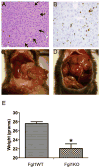Targeted disruption of fibrinogen like protein-1 accelerates hepatocellular carcinoma development
- PMID: 26225745
- PMCID: PMC4594872
- DOI: 10.1016/j.bbrc.2015.07.078
Targeted disruption of fibrinogen like protein-1 accelerates hepatocellular carcinoma development
Abstract
Fibrinogen like protein-1 (Fgl1) is a predominantly liver expressed protein that has been implicated as both a hepatoprotectant and a hepatocyte mitogen. Fgl1 expression is decreased in hepatocellular carcinoma (HCC) and its loss correlates with a poorly differentiated phenotype. To better elucidate the role of Fgl1 in hepatocarcinogenesis, we treated mice wild type or null for Fgl1 with diethyl nitrosamine and monitored for incidence of hepatocellular cancer. We find that mice lacking Fgl1 develop HCC at more than twice the rate of wild type mice. We show that hepatocellular cancers from Fgl1 null mice are molecularly distinct from those of the wild type mice. In tumors from Fgl1 null mice there is enhanced activation of Akt and downstream targets of the mammalian target of rapamycin (mTOR). In addition, there is paradoxical up regulation of putative hepatocellular cancer tumor suppressors; tripartite motif-containing protein 35 (Trim35) and tumor necrosis factor super family 10b (Tnfrsf10b). Taken together, these findings suggest that Fgl1 acts as a tumor suppressor in hepatocellular cancer through an Akt dependent mechanism and supports its role as a potential therapeutic target in HCC.
Keywords: Diethyl nitrosamine; Fibrinogen like protein-1; Hepatocellular carcinoma; Hepatoprotecatant; Mitogen.
Copyright © 2015 Elsevier Inc. All rights reserved.
Figures




References
-
- Yamamoto T, Gotoh M, Sasaki H, Terada M, Kitajima M, Hirohashi S. Molecular cloning and initial characterization of a novel fibrinogen-related gene, HFREP-1. Biochem Biophys Res Commun. 1993;193:681–687. - PubMed
-
- Hara H, Yoshimura H, Uchida S, Toyoda Y, Aoki M, Sakai Y, Morimoto S, Shiokawa K. Molecular cloning and functional expression analysis of a cDNA for human hepassocin, a liver-specific protein with hepatocyte mitogenic activity. Biochim Biophys Acta. 2001;1520:45–53. - PubMed
-
- Hara H, et al. Isolation and characterization of a novel liver-specific gene, hepassocin, upregulated during liver regeneration. Biochim Biophys Acta. 2000;1492:31–44. - PubMed
-
- Yan J, Ying H, Gu F, He J, Li YL, Liu HM, Xu YH. Cloning and characterization of a mouse liver-specific gene mfrep-1, up-regulated in liver regeneration. Cell Res. 2002;12:353–361. - PubMed
Publication types
MeSH terms
Substances
Grants and funding
LinkOut - more resources
Full Text Sources
Other Literature Sources
Medical
Molecular Biology Databases
Research Materials
Miscellaneous

